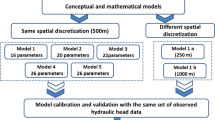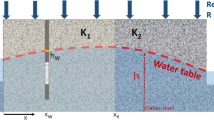Abstract
Considering complexity in groundwater modeling can aid in selecting an optimal model, and can avoid over parameterization, model uncertainty, and misleading conclusions. This study was designed to determine the uncertainty arising from model complexity, and to identify how complexity affects model uncertainty. The Ajabshir aquifer, located in East Azerbaijan, Iran, was used for comprehensive hydrogeological studies and modeling. Six unique conceptual models with four different degrees of complexity measured by the number of calibrated model parameters (6, 10, 10, 13, 13 and 15 parameters) were compared and characterized with alternative geological interpretations, recharge estimates and boundary conditions. The models were developed with Model Muse and calibrated using UCODE with the same set of observed data of hydraulic head. Different methods were used to calculate model probability and model weight to explore model complexity, including Bayesian model averaging, model selection criteria, and multicriteria decision-making (MCDM). With the model selection criteria of AIC, AICc and BIC, the simplest model received the highest model probability. The model selection criterion, KIC, and the MCDM method, in addition to considering the quality of model fit between observed and simulated data and the number of calibrated parameters, also consider uncertainty in parameter estimates with a Fisher information matrix. KIC and MCDM selected a model with moderate complexity (10 parameters) and the best parameter estimation (model 3) as the best models, over another model with the same degree of complexity (model 2). The results of these comparisons show that in choosing between models, priority should be given to quality of the data and parameter estimation rather than degree of complexity.







Similar content being viewed by others
References
Akaike H (1974) A new look at the statistical model identification. IEEE Trans Automat Control 19:716–723. doi:10.1109/TAC.1974.1100705
Chang DY (1996) Applications of the extent analysis method on fuzzy AHP. Eur J Oper Res 95:649–655. doi:10.1016/0377-2217(95)00300-2
Collyer CE (1985) Comparing strong and weak models by fitting them to computer-generated data. Atten Percept Psychophys 38:476–481. doi:10.3758/BF03207179
Dai Z, Samper J (2004) Inverse problem of multicomponent reactive chemical transport in porous media: formulation and applications. Water Resour Res. doi:10.1029/2004WR003248
Dai H, Ye M (2015) Variance-based global sensitivity analysis for multiple scenarios and models with implementation using sparse grid collocation. J Hydrol 528:286–300. doi:10.1016/j.jhydrol.2015.06.034
Dai Z, Samper J, Wolfsberg A, Levitt D (2008) Identification of relative conductivity models for water flow and solute transport in unsaturated bentonite. Phys Chem Earth 33:177–185. doi:10.1016/j.pce.2008.10.012
Dai Z, Wolfsberg A, Reimus P, Deng H, Kwicklis E, Ding M, Ye M (2012) Identification of sorption processes and parameters for radionuclide transport in fractured rock. J. Hydrol 414:220–230. doi:10.1016/j.jhydrol.2011.10.035
Diks CGH, Vrugt JA (2010) Comparison of point forecast accuracy of model averaging methods in hydrologic applications. Stoch Env Res Risk A 24:809–820. doi:10.1007/s00477-010-0378-z
Duan Q, Ajami N, Gao X, Sorooshian S (2007) Multi-model ensemble hydrologic prediction using Bayesian model averaging. Adv Water Resour 30:1371–1386. doi:10.1016/j.advwatres.2006.11.014
Dubois D, Prade H (1980) Fuzzy sets and systems: theory and applications. Academic Press, New York
Emberger F (1969) Climatique la Tunisia. Instituto Agronomico perl’Oltremare 31–52
Engelhardt I, De Aguinaga JG, Mikat H, Schüth C, Liedl R (2014) Complexity vs. simplicity: groundwater model ranking using information criteria. Ground Water 52:573–583. doi:10.1111/gwat.12080
Environmental Simulations Inc (ESI) (2007) Guides to using Ground Water Vista: version 5
Freyberg DL (1988) An exercise in ground-water model calibration and prediction. Ground Water 26:350–360. doi:10.1111/j.1745-6584.1988.tb00399
Haitjema H (2011) Model complexity: a cost-benefit issue. GSA Today 43:354
Harbaugh AW (2005). MODFLOW-2005, the US Geological Survey modular ground-water model: the ground-water flow process. US Department of the Interior, US Geological Survey, Reston, pp. 6–A16
Hill MC (1998) Methods and guidelines for effective model calibration. US Geological Survey. Colorado, Denver, p 90
Hill MC (2006) The practical use of simplicity in developing ground water models. Ground Water 44:775–781. doi:10.1111/j.1745-6584.2006.00227
Hill MC, Tiedeman CR (2007) Effective groundwater model calibration: with analysis of data, sensitivities, predictions, and uncertainty. Wiley, New Jersey
Hojberg AL, Refsgaard JC (2005) Model uncertainty-parametric uncertainty versus conceptual mode. Water Sci Technol 6:153–160
Hunt RJ, Zheng C (1999) Debating complexity in modeling. EOS Trans Am Geophys Union 80:29. doi:10.1029/99EO00025
Hunt RJ, Doherty J, Tonkin MJ (2007) Are models too simple? Arguments for increased parameterization. Ground Water 45:254–262. doi:10.1111/j.1745-6584.2007.00316
Hurvich CM, Tsai CL (1989) Regression and time series model selection in small samples. Biometrika 76:297–307. doi:10.1093/biomet/76.2.297
Jacobs AM, Grainger J (1994) Models of visual word recognition: sampling the state of the art. J Exp Psychol Hum 20:1311. doi:10.1037/0096-1523.20.6.1311
Kashyap RL (1982) Optimal choice of AR and MA parts in autoregressive moving average models. IEEE Trans Pattern Anal. doi:10.1109/TPAMI.1982.4767213
Kishore P, Padmanabhan G (2016) An integrated approach of fuzzy AHP and fuzzy TOPSIS to select logistics service provider. J Manuf Sci 16:51–59. doi:10.1515/jmsp-2015-0017
Kuchanur MP (2006) Simulation-Optimization methodologies to estimate groundwater availability. Dissertation, Texas A&M University-Kingsville
Liu P, Elshall AS, Ye M, Beerli P, Zeng X, Lu D, Tao Y (2016) Evaluating marginal likelihood with thermodynamic integration method and comparison with several other numerical methods. Water Resour Res. doi:10.1002/2014WR016718
Meyer PD, Ye M, Neuman SP, Rockhold ML, Cantrell KJ, Nicholson TJ (2007) Combined estimation of hydrogeologic conceptual model, parameter, and scenario uncertainty. Rep.NUREG/CR-6940 PNNL-16396, U.S. Nucl. Regul. Comm., Washington, DC
Nettasana T (2012) Conceptual Model Uncertainty in the Management of the Chi River Basin, Thailand. Dissertation, University of Waterloo
Neuman SP (2003) Maximum likelihood Bayesian averaging of uncertain model predictions. Stoch Env Res Risk A 17:291–305. doi:10.1007/s00477-003-0151-7
Oreskes N (2000) Why believe a computer? Models, measures, and meaning in the natural system. In: Schneiderman JS (ed) The earth around us: maintaining a livable planet. W. H. Freeman and co., San Francisco, pp 70–82
Oreskes N (2003) The role of quantitative models in science. In Lauenroth WK, Canham CD, Cole JJ (eds) Models in ecosystem science. Princeton University Press, Princeton, pp 13–31
Patil SK, Kant R (2014) A fuzzy AHP-TOPSIS framework for ranking the solutions of knowledge management adoption in supply chain to overcome its barriers. Expert Syst Appl 41:679–693. doi:10.1016/j.eswa.2013.07.093
Poeter E, Anderson DR (2005) Multimodel ranking and inference in groundwater modeling. Ground Water 4:597–605. doi:10.1111/j.1745-6584.2005.0061.x
Poeter EP, Hill MC, Banta ER, Mehl Steffen, Christensen Steen (2005) UCODE_2005 and six other computer codes for universal sensitivity analysis, calibration, and uncertainty evaluation constructed using the JUPITER API: U.S. Geological Survey Techniques and Methods, bk. 6, chap. A11, revision of Feb, Virginia
Pohlmann K, Ye M, Reeves D, Zavarin M, Decker D, Chapman J (2007) Modeling of groundwater flow and radionuclide transport at the Climax mine sub-CAU, Nevada Test Site (No. DOE/NV/26383-06; 45226). Desert Research Institute, Nevada System of Higher Education, Reno
Popper KR (1982) The open universe: an argument for indeterminism. In: Bartley WW (ed) The postscript to the logic of scientific discovery, III edn. Hutchinson, London
Rissanen J (1978) Modeling by shortest data description. Automatica 14:465–471
Rojas R, Feyen L, Dassargues A (2008) Conceptual model uncertainty in groundwater modeling: combining generalized likelihood uncertainty estimation and Bayesian model averaging. Water Resour Res. doi:10.1029/2008WR006908
Samani S, Moghaddam AA (2015) Hydrogeochemical characteristics and origin of salinity in Ajabshir aquifer, East Azerbaijan, Iran. Q J Eng Geol Hydrogeol 48:175–189. doi: 10.1144/qjegh2014-070
Schwarz G (1978) Estimating the dimension of a model. Ann Stat 6:461–464
Simmons CT, Hunt RJ (2012) Updating the debate on model complexity. GSA Today 22:28–29. doi:10.1130/GSATG150GW.1
Singh A, Mishra S, Ruskauff G (2010) Model averaging techniques for quantifying conceptual model uncertainty. Ground Water 48:701–715. doi:10.1111/j.1745-6584.2009.00642
Sun NZ (1994) Inverse problems in groundwater modeling. Theory and applications of transport in porous media, vol 6. Kluwer Academic, Dordrecht
Sun CC (2010) A performance evaluation model by integrating fuzzy AHP and fuzzy TOPSIS methods. Expert Syst Appl 37:7745–7754. doi:10.1016/j.eswa.2010.04.066
Swaify SA, Yakowitz DS (1998) Multiple objective decision making for land, water, and environmental management. In Towards sustainable land use. Furthering cooperation between people and institutions. vol 1. Proceedings of the International Soil Conservation Organisation, Bonn, Germany
Szidarovsky F, Gershon M, Duckstein L (1986) Techniques for multiobjective decision making in systems management. Elsevier, Amsterdam
Ye M, Neuman SP, Meyer PD (2004) Maximum likelihood Bayesian averaging of spatial variability models in unsaturated fractured tuff. Water Resour Res. doi:10.1029/2003WR002557
Ye M, Meyer PD, Neuman SP (2008a) On model selection criteria in multi model analysis. Water Resour Res. doi:10.1029/2008WR006803
Ye M, Pohlmann KF, Chapman JB (2008b) Expert elicitation of recharge model probabilities for the Death Valley regional flow system. J Hydrol 354:102–115. doi:10.1016/j.jhydrol.2008.03.001
Ye M, Pohlmann KF, Chapman JB, Pohll GM, Reeves DM (2010) A model-averaging method for assessing groundwater conceptual model uncertainty. Ground Water 48:716–728. doi:10.1111/j.1745-6584.2009.00633
Yeh WG, Yoon YS (1981) Aquifer parameter identification with optimum dimension in parameterization. Water Resour Res 17:664–672. doi:10.1029/WR017i003p00664
Zadeh LA (1965) Fuzzy sets. Inform. Control 8:338–353. doi:10.1016/S0019-9958(65)90241-X
Zeleny M (1982) Multiple criteria decision Making. McGraw-Hill Book Company, New York
Acknowledgements
This work was supported by the Tabriz University. The third author was supported in part by DOE Early Career Award DE-SC0008272 and NSF-EAR Grant 1552329. We thank K. Shashok (Author AID in the Eastern Mediterranean) for technial editing.
Author information
Authors and Affiliations
Corresponding author
Rights and permissions
About this article
Cite this article
Samani, S., Moghaddam, A.A. & Ye, M. Investigating the effect of complexity on groundwater flow modeling uncertainty. Stoch Environ Res Risk Assess 32, 643–659 (2018). https://doi.org/10.1007/s00477-017-1436-6
Published:
Issue Date:
DOI: https://doi.org/10.1007/s00477-017-1436-6




